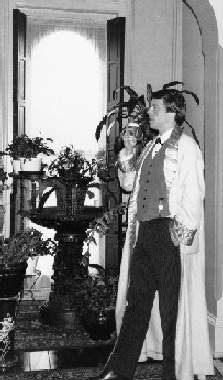Gibson and Sherwood decided immediately not to dramatize existing works by Doyle or other writers. After all, some participants might have read these, and know their solutions. No, the Villa's "cases" must be new works. But they must be true to the format that Doyle established, of real-world dilemmas fairly solved in a real-world manner. But even that was daunting enough, because of the huge global reputation that has been built up for the character.

Sherlock Holmes is one of the world's most familiar icons. Everyone, it seems, has a notion -- caricatured or otherwise -- about the character and his abilities. But certain things are set in stone by Holmes's most profound admirers, people who've re-read and memorized the details of each of the Doyle stories as well as the informed conjectures by such writers as W.S. Baring-Gould.
Such "facts" that could not be changed would be Holmes's birth in 1854 in Yorkshire, the existence of his more intelligent brother Mycroft, his distrust of women, his longtime use of cocaine (fortunately, Doyle had Watson "wean" him from the drug in his later years) and his retirement in 1903 to keep bees on a Sussex farm.
The Villa maintains a Victorian ambience, but it would be impossible to transport visitors back to a time when automobiles, radios, pocket calculators, cel phones and pagers weren't ever-present. Gibson and Sherwood agreed that, Holmes would be a visitor from the current era. That, of course, would make Holmes much more than a century old. How would that be possible? Why, Sherwood suggested, the hyperintelligent Holmes might have invented a rejuvenating elixir from the royal jelly he drew from his bee-hives. Holmes and Watson might be ageless! End of problem.

Another challenge was that the Villa is a non-smoking establishment. Without his pipe, of course, Holmes would be only half an icon, if that, and difficult to accept. So Gibson agreed that Sherwood would be the only person with permission to smoke inside the inn. Sherwood, who doesn't smoke, had to familiarize himself with all the kinds of tobacco with which Holmes was associated -- pipes, cigarettes, cigars and even snuff.
Why was the Duo in Union City at all? Because Ron Gibson was the great- grandson of J. Neil Gibson, the "gold king," a former U.S. senator whom Holmes had assisted in the Doylean case titled "The Problem of Thor Bridge." The Gibson family had kept in touch with Watson, who enjoyed visiting young Ronald's establishment in Michigan -- and prescribing a frequent weekend of "rest" for his friend.
Sherwood sought advice about constructing a perplexing, challenging yet fair-minded mystery, beyond the insights gleaned from a close study of Doyle's works. His contacts included an eminent Sherlockian collector, the late John Bennett Shaw, as well as members of a nearby Baker Street Irregulars scion society, the Arcadia Mixture of Ann Arbor, where writers Lloyd Biggle Jr. and Loren Estleman provided valuable tips and encouragement.
Sherwood asked himself, "If I were to join Holmes on a case, what would I expect to experience?" Obviously, authenticity was to be the philosophy. The mystery had to be intriguing and involving, something that would demand attention. Clues would be hard to spot, yet revealing and -- above all -- realistic. And things would not be "made easy." Nothing would be dumbed-down. Guests would be regarded as fellow reasoners and sleuths, and would have to work hard if they wanted to solve the case. And, of course, those who succeeded would receive due honors and a reward.
For the utmost in realism, Sherwood believed the Union City Police Department should be "on hand" to assist in the arrest of a perpetrator. For years, that's exactly what happened, and police officer Charles Swarthout often arrived to lend authenticity to the atmosphere, with other police officers and deputies replacing him on occasion.
221B Baker Street - Visit the Sherlock Holmes Museum in London
Go to John Sherwood's performance credits.
Since April 1997, we have had this many visitors:
